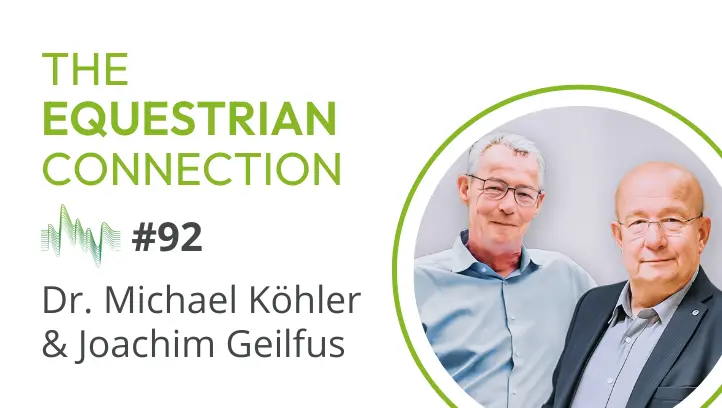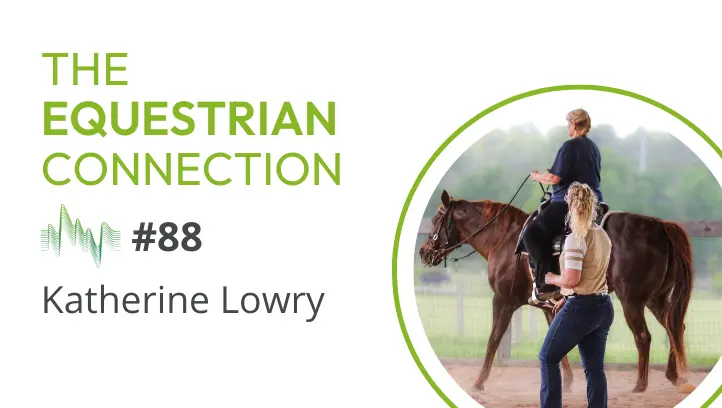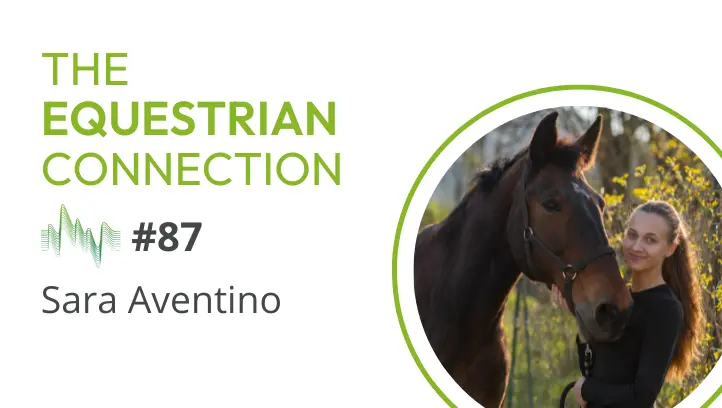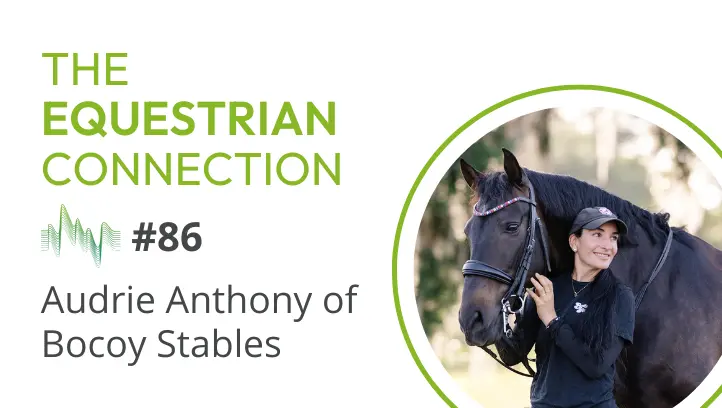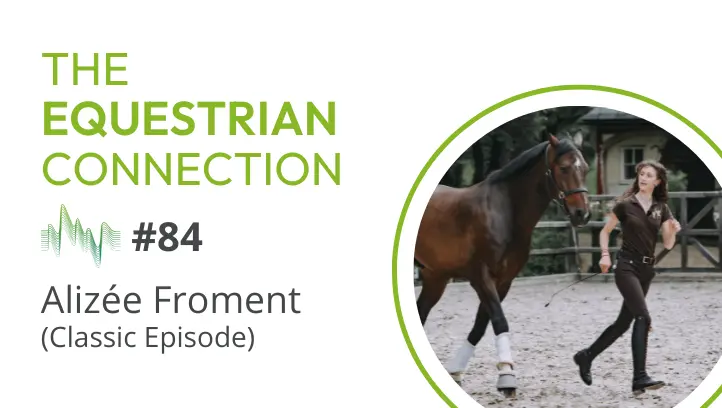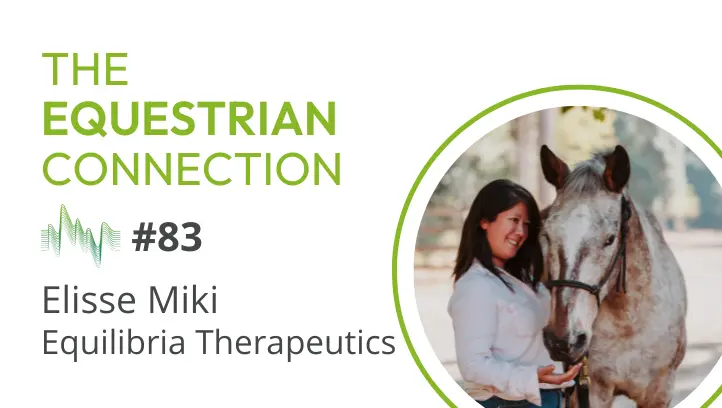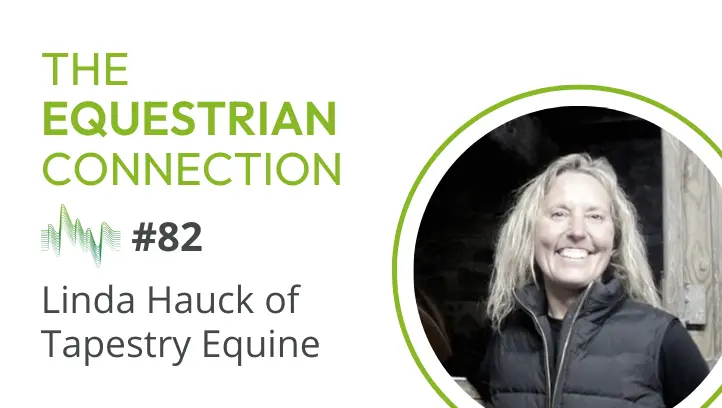#4 Linda Tellington Jones: Founder of the World Renowned TTouch Method
In this Podcast Episode we have the world-famous Linda Tellington Jones as a guest. She is well known for her Tellington TTouch Method, which is also scientifically proven.
Linda speaks with us about her view and beliefs about horses and how her famous TTouch can improve the well-being and performance of every horse. As the TTouch Method can bring your horse in a mental, physical, and emotional balance.
She also explains how each TTouch works and how the method can be perfectly integrated into everyday life.
Podcast Transcript
This transcript was created by an AI and has not been proofread.
This transcript was created by AI and has not been proofread
[SPEAKER 2]Hi everyone, this is the Equestrian Experience from wehorse, the online riding academy. My name is Christian Kroeber and I am super excited about today’s episode. One of the most inspiring influences on the equestrian world is Linda Tellington-Jones. Living on Big Island, Hawaii, she has been traveling the world for the last decades to teach and instruct people on T-Touch, the method she established and founded. It is a specialized approach to the care and training of horses and having pioneered horse training, she has worked with many of the best equestrians in the world, Olympians, world champions and many many more to help them improve their performance and training of their horses. Nevertheless, it is a technique and a method to be used by everyone, so let’s listen in. We’ve been working with you for such a long time and we’re so glad to have you. Hello, Linda Tellington-Jones.
[SPEAKER 1]Hello, I’m very excited also.
[SPEAKER 2]Linda, you’ve been around in the horse world for so many decades. You’ve been treating horses in Europe, throughout the world, in the States, and you brought your word out for the T-Touch and the T-Touch method. Today I want to talk to you or with you about your career, the way you treat horses, the way you relate to horses. So what is precisely the T-Touch method?
[SPEAKER 1]Well, the T-Touch Method is the whole, it’s actually the Tellington Method, Tellington T-Touch Method. It’s a way of being with horses, recognizing and working with the body, mind and soul of the horse and working with the horse to bring them to a place of mental, physical and emotional balance so that they’re safer to be around. And for me, it’s really interesting. I want a horse to enjoy being with me as much as I like being with a horse. And that’s what the method does, is actually give you a way of relating to a horse in a different way, so that you’re leading the dance without dominance, which is really different.
[SPEAKER 2]The T-Touch method of course comprises of the T-Touch. What precisely is the T-Touch compared to the three other aspects covering the method?
[SPEAKER 1]Right, the first is the T-Touch part is the body work, the work that we do in the body. And the primary interest is just bring that horse to a place of connection to the whole body groundedness so that they instead of going automatically like course instinctively like horses do to the place of flight or fight or freeze or fool around they come to a place of trust And in that way, it’s possible to be a whole lot safer around horses and actually be more successful in whatever you want to do with them because there’s a relationship, a cooperation between you and the horse that the T-Touch brings. And it’s really funny because often, I also work with other animals, with zoo animals, and often What I’m asked is, Linda, how do you know so much about, you know, horses or animals and how do you connect in this way? And it’s not that I know so much. It’s yeah, with horses, it’s a, you know, a lifelong experience. But what I really connect at a cell to cell level. which sounds really weird, you don’t have to do it to be successful, but it’s a level of heart to heart, cell to cell, and soul to soul level, and horses knew it when you approach them from that point of view.
[SPEAKER 2]To relate that to your personal history, how did you come up with this method and how did you find out that there is a way of treating horses differently, also with a posture towards it, to really make a difference?
[SPEAKER 1]Well, I’m really blessed that I had to ride to school for the first six years of my life. Six years old, stuck on a horse that my father bought for me, riding down the road several kilometers to school with my cousins.
[SPEAKER 2]In Canada.
[SPEAKER 1]In Canada, right. In rural Canada. Gibbons, Alberta. And so, I mean, I rode every single day. And then when I was nine, we moved closer to Edmonton. I still had to ride to school, but then I started riding at a riding stable. And so I would ride to school, horse goes in the barn, ride home, ride to then other direction to the stable and ride two or three horses. And so I was really, and I was really blessed to have a grandfather who put his hands on horses in a way that was different. I mean, I can remember very well when I was maybe nine or 10 and I was looking at a horse with him and he just gave me a connection through my hands on that horse that I think has probably influenced everything I’ve done. It’s odd, it’s odd when I think about it. And so, I started catch riding horses in horse shows when I was like 12, in big horse shows, nine-day shows. Rode a lot of really good horses, won a lot, and then I actually I don’t know how long you want this story because we could actually do several podcasts.
[SPEAKER 2]Go on forever probably.
[SPEAKER 1]Right, so we have to cut it short. So we’ll cut to short.
[SPEAKER 2]But what really interests me is there’s a scientific background to your method. Yes. Unlike many other methods out there. True. How did you come up with this scientific approach to it?
[SPEAKER 1]I think that’s a really good question. I was blessed to marry a man 20 years older than I, Wentworth Tellington, and he had a background. He graduated from the last cavalry class in the United States the year I was born. And he, you know, and as a cavalry officer they have a tremendous amount of training and he was also a engineer and a scientist and always really interested in why things work, what can we prove with it. We were working with a with the University of California vet school in those days. We were always looking and we had what we called a clinical research firm. So Wendt was always looking for proof behind something. Why does it work? How can we be more successful? And the thing I’m really lucky about, Wendt’s whole philosophy was this idea that you don’t hoard information, you share information. That’s really different in the horse world, because everybody wants their secrets, why they’re successful. And Wendt’s whole concept, how can we share? And so I, you know, kind of grew up, you can say. with this idea, how can I better understand what’s behind the reasoning for horses doing what they do? And of course, reading a lot, studying a lot, but also doing these studies on pulse and respiration and temperature. And because we did a lot of endurance riding and we were always looking for better ways to feed horses, better ways to transport them, better ways to train them. Of course, that’s been one of my primary focuses since I was 12, actually. How do we train a horse without bucking them out, without them being traumatized? And that’s what I’ve been doing.
[SPEAKER 2]Still nowadays there’s plenty of equine research going on, but what were your key findings that you transferred into your method?
[SPEAKER 1]That’s a really good point. I mean, one, I have to, no one ever asked me that question, so I have to really think about that. It was, It started with the fact when we started doing tests for pulse and respiration, for instance, when we were training. But then when we were trailering horses and designing, designed a backwards riding trailer and found out pulse and respiration stays way lower. And then just over the years, because we had that school, a nine-month residential school for riding instructors in California, for 10 years, and because we had that, I was always looking for what’s behind it, how can I prove scientifically that this is right? And so we’ve been playing like the latest coming up to date now is what we do with the concepts of HeartMath Institute with heart coherence using an M-Wave. You can go online and get it on your smartphone. And that has carried through, like, over all these years. Always looking how to keep the horse successful, healthy, happy, and listen to us. And I think, you know, actually a good way to find the answer to that question is look on my website, because I’ve listed all the scientific studies that we’ve done and had done on the work over the years, and it’s a lot.
[SPEAKER 2]And especially with heart coherence, we have material with you, the videos we have on our platform with you, and you talk about heart coherence there as well. If you want to learn more about Linda’s philosophy and her T-touches, we have four comprehensive courses on weaos.com covering her method from A to Z with real-life application examples and how you can learn it either from scratch or if you’re already more experienced, integrate it into your daily routine. So four courses of the T-touch on weaos.com and now let’s get back to Linda. When we think about the modern days, how the equestrian world is set up nowadays, how can people involved with T-Touch, the method, and apply it to their daily work?
[SPEAKER 1]Just by, from before you even put your hands on that horse, get yourself grounded. This is, you can, you’re having the books for sale, show it. We’re going to be showing it on the videos. Ground with the heart hug, ground with the ear work, breathe, become aware of your groundedness and your connection. When you do, The studies show, from Hartmath for instance, that the horse wants to be with you. That’s actually proven. And so my books, two of my books, have the subtitles of Riding into the 21st Century. We need to look at the science behind. stress in horses. Oh my god, think about it. 20, a little more than 20 years ago, the word stress just started in the horse world. We never heard it. We didn’t even know it was an issue. And for me, what’s really exciting is understanding the concepts of when a horse is in fight or flight, in other words, under the control of the sympathetic nervous system, or we can put them in that place of rest and recovery and focus, like quiet, focused energy of the parasympathetic. And I started looking at that, man, it’s over 20 years ago. And it’s in my books, and I don’t understand why people don’t know how important that is. But that’s how you touch them all over in the body that we show in the videos. It’s how you groom them just from your… And also, how you think of them. I mean, so many people say, my horse is crazy. Horses that are spooky and it scares them. Really? Is that really true that your horse is crazy? What does that mean to you? Or my horse is really dominant. Well, they won’t stand still. They’re throwing their head. They’re snapping at the air. And we show this. I mean, I love what we have on the video showing, wait a minute. Listen, that’s the language of the horse. When they lift a leg, like you’ll see, or they threaten to kick or just pick up and, you know, they won’t stand still and they roll their head around. People say, oh, my horse is dominant. What? That’s a strange word, I think, for the reason that you’re acting like it’s consciously trying to control you. I don’t believe that. We used to call it resistant in the horse world, and that makes much more sense. Yes, they’re resistant, but where’s our role in that? And since we pay the feed bills and lead the dance, and I know how important it is for a rider to stay safe, It behooves you to do this work that we do with the Tellington T-Touch Method as part of it. Work on the ground, getting the head down, putting your hands over the entire horse, which we show in lots of different ways. You will be not just a better rider and be able to relate to your horse in a different way, but it will give you a sense of your own control, of your own well-being. by working with your horse in this way.
[SPEAKER 2]Which is very good for both the human being and the horse, which is great that the method can improve both both beings, unlike other methods. You talked about grooming and how would you in modern days describe grooming and how could it potentially be improved? You were talking about scientific facts that we have to arrive in the modern world. How’s that relating to the way we treat horses at the moment?
[SPEAKER 1]Huge, I mean, one of the big things, and this is actually in one of my books, Thank God, in the Dressage book, writing with, what’s it called, Body, Mind, and Soul. The idea that if you don’t tighten your noseband and your girth really tight, you’re not a rider, right? Everybody thinks you just do it. There’s really valuable, important, really clear research showing that, holy mackerel, as soon as you tighten that noseband, the pulse just shoots up over 100. And one of our young vet students at the University of Guelph, Ontario, did a study on the stress levels in horses loading them into a trailer with the Tellington method or using other methods. And there was a significantly measurable difference in the horse’s blood pressure and pulse and respiration. The same thing with people. One of the first studies that we did was in in 1909, I believe it was, at the University of Minnesota. A really interesting study with 160 soldiers was done showing, and these were all people that said, oh my god, they were really afraid of getting inoculations. So somebody who didn’t know anything about T-Touch was just shown move the skin in a circle and a quarter for three minutes, lightly, just lightly, and a pulse respiration and blood pressure of everybody who normally shoots up stayed down. And that’s what you know that validated what we were seeing in the horses because we can we can tell when you get your horse to keep the head a little level instead of shooting up in that flight position that they can listen to you way safer and I think the videos you’re making are really important because There are so many accidents now in the horse world because people are coming too fast, not taking time to prepare their horse. They’re stressed and rushed. And that’s why the hard hugs that we show for riders can keep you safer and really improve your own level of health.
[SPEAKER 2]The hard tacks and the T-touches themselves, you always talk about one and a quarter. Why is it one and a quarter and not one and three quarters?
[SPEAKER 1]This is a really good question. Because in the very beginning, when I first got the concept of move the skin in a circle as a response to what are you doing, It was 1983, and I remember the exact moment. And I just said, move the skin in a circle. So I just moved the skin in one circle. And that is, I would start at one point, go around, and stop at that point, which is better than going, na, na, na, na, na, na, and several points, because I have to stay present. OK, good. The only thing is, when you only do one circle, It just didn’t feel finished. So we said, okay, do one and a little more. Okay, that’s in some of the literature. One and a little more. Hmm, okay. But then when we started writing a lot about it, one and a little more, it’s a lot to write. So that’s at one point we just say, wait a minute, do one and a quarter. And then we started actually doing the one and a quarter where you stay present. That means you have to stop at that quarter point. And magic started to happen. The person feeling it thought, whoa, that really is different. That really feels complete. And you could see the horses would start to to stop and listen. And I mean, gosh, I’ve been at this a long time. The circular tea touch came into my hands in 1983 in July. And I feel I’m just scratching the surface with the studies we’ve done with the Pop Institute and and other studies. But you see, I think what we’re looking at here and why horses start to listen is this whole concept of the magic spiral that’s in nature. But look, it took me years to get there. I was just doing a little more and then trying. Oh, whoa, that really works. That’s how we do it.
[SPEAKER 2]But there are also variations and pressure for the touches. I think 10 in total.
[SPEAKER 1]Well, we say work from 1 to 10. Why do we say that? Because in all the years I’ve been working on people, which is more since 83, I mean, I started right then working on people with the circular one and a quarter touches, the basic detouch. Since that time, I have worked on three people with a 10. And everybody else I’ve been working, I’d say mostly between a two and a four and a maybe five, not more. So they say, well, why don’t you just have it? Because you’d have no idea how light that is if you didn’t know, oh my God, there is a 10. And it’s wild how little it takes.
[SPEAKER 2]Why is there a difference between a touch of a two or a 7? What makes you alter on the scale from 2 to 7 or even a 10?
[SPEAKER 1]Great question. First of all, with humans, one of the concepts with this work is that we ask the person, do you like a little lighter pressure from what I’m using or would you like a little more? We don’t necessarily give a number. You don’t have to. And it’s unbelievable how often they say, I would say more than 70% say, ah, I like it. Either the same or lighter. You would never expect that. And then we say, OK, would you like it faster or slower? Would you like pause, a pause, after each circle and a quarter? So why are we doing this? First of all, that’s how we know from the feedback of people, from horses. Watch what your horse says. I mean, I’ve had horses that I could only put like the back of my hand on, which we call the llama touch, which is an interesting story behind it. And because it’s not threatening. And sometimes we can’t even, we have to work a circle underwear off the body, off the body. It’s so threatening on the body. So how do you think those horses are going to be with the pressure of the saddle and the girth and the bit and all that? Not safe. And so we make them have the possibility of a connection and a feeling of safety and ground and dust all four feet on the ground. And then the rider is safer.
[SPEAKER 2]At the very same time, activation of the cell, because the concept underlies the greater concept that all cells are interconnected.
[SPEAKER 1]Yes, and there’s communication between them. And that’s thanks to the work of Dr. Fritz Albert Popp here in Germany. I mean, it’s incredible studies over the years, world-recognized. But you don’t have to think about that, you don’t have to believe that our cells are intelligent and every cell has its own nervous system, you don’t have to know that stuff. So just put your hands on your horse and give them a sense of being able to breathe when you touch them, because it will change the horse’s health, mental, physical, and emotional health. And the really interesting thing is it affects the rider’s health. If your horse is tense, and the head is up, and the horse is kind of flipping the head around and snapping at the air, and you think any moment you’re going to have this nice explosion, boy, not good for your immune system.
[SPEAKER 2]Many great writers like the German Olympian Klaus Balkenhol, writers from Canada, from the States, all over Europe value your work. Is it also performance enhancing?
[SPEAKER 1]Oh, absolutely. There’s no comparison, I believe, in when a horse is feeling their whole body and that they can, and when they’re in a state under the parasympathetic nervous system, and I keep bringing this in because it behooves every thinking horse person to understand what does that mean to your safety and to your performance and your horse.
[SPEAKER 2]I think it’s really well explained in the videos, but it’s really also for people that not only care about the health, the safety aspect, also the performance aspect.
[SPEAKER 1]Yes, and you win better with it.
[SPEAKER 2]Yes, absolutely. And you yourself, using this method, back in the days, were more successful than before.
[SPEAKER 1]No question. Absolutely. And I mean, it’s really interesting. I went with South Balkan Hall years ago to Stuttgart with Garcon.
[SPEAKER 2]A show in Germany, by the way. Big horse show in Germany.
[SPEAKER 1]Big horse show in Germany. And normally this stallion, he wouldn’t sleep well, he wouldn’t eat well at a show, and he’d be pretty good the first day and he’d get less and less successful as the week went on because he didn’t sleep well, because he didn’t rest and eat. And so I would work him every day, 30 minutes, six o’clock in the morning, 10 minutes before Clouds Road, and the horse won the Grand Prix, the Grand Prix Special, and the Coeur that year.
[SPEAKER 2]The freestyle.
[SPEAKER 1]The freestyle, right. Yeah, and in dressage, for those who don’t know who Klaus Balkenholm, gold medal winner is, right? And so just by working on the body of the horse, that made him able to rest, perform, not get tired muscles because he was working hard and didn’t sleep.
[SPEAKER 2]I think that’s what really comes through in the material we have with you. You’ve been with us for, what is it, 30 years almost?
[SPEAKER 1]Yeah, 23. I just found out, 23.
[SPEAKER 2]And at the end of each podcast, we have four classic questions. And the first is, don’t worry, you’ll be fine.
[SPEAKER 1]I love questions.
[SPEAKER 2]I love them. Do you have a motto?
[SPEAKER 1]Yes. Join me in changing the world one tea touch at a time.
[SPEAKER 2]Great. The second is, who inspired you the most in your life?
[SPEAKER 1]Oh, my goodness. That is a really, really good question. Who inspired me the most? You know, I’ve been really blessed to read. I love to study. And so Greg Brayden in his books, The Divine Matrix. One of his books is Secrets of the Lost Mode of Prayer. He’s a scientist who has turned philosopher visionary. And so that’s been a huge, his work has been a huge inspiration. And Lynn McTaggart, and I actually have done a Zoom book clubs discussing these books because I get a lot of my inspiration from reading and knowing these people and Bruce Lipton and his concept, the fact that we can actually change our DNA by our thinking. And I know it personally and I know both of them personally. And so these visionaries, these who are bringing this concepts into the 21st century that we with proof from all the studies that have been done showing that what we think actually affects what our lives are.
[SPEAKER 2]The way we treat horses.
[SPEAKER 1]The way we treat horses and the way our lives are. And so that’s why one of my, well, ask more questions. I don’t want to talk too much.
[SPEAKER 2]So we recognize there are plenty of people that inspired you.
[SPEAKER 1]There are a lot, but I have to really, I have to think about them and that I, Many, many people inspired me. Let me just see if I can kind of pick out of the air. I was going to say a human other than an author. I mean, seriously, I am so influenced and so grateful for these incredible visionaries that we have in the 21st century. And actually, I want to tell you one that’s really cool about, and it relates to our horses, and it’s Dr. Larry Dossey. In his book, oh God, which I’ve written, I’ve read quite a few, I’ll think about the title in a second. In his book, I memorized this statement, that the mind, our mind is infinite. that my mind touches and is touched by everyone’s and all minds are linked. And this is true with our animals too. And so when we know that what we think and what we feel emotionally actually affects the performance of our horse. And so we need in the 21st century as riders to understand what that means with our breathing, with our positive thinking, with our heart coherence. And, I mean, for me, like practicing, instead of saying, oh, my horse today wasn’t good, say, wait a minute, what did your horse do today that was good? Whenever you focus on the positive instead of what went wrong, your life, you’ll be more successful.
[SPEAKER 2]Maybe that relates to the next question, the third of our four classical failure questions. If you could recommend one thing, only one thing, Linda, to a rider, what would it be?
[SPEAKER 1]Oh, that’s a really simple one. And that is like a mantra that thanks to my mom, I’ve had, I mean, as long as I can remember. And that’s treat your horse as you would like to be treated. It is the golden rule for humans and for human horse relationships.
[SPEAKER 2]And the last is, please complete this sentence for me. For me, horses are
[SPEAKER 1]Oh, for me, horses are a connection to the whole universe. And why do I say that? Think about pegasus. How many little kids, girls, I don’t know about little boys, how that is for little boys, but for little girls, they dream about Pegasus.
[SPEAKER 2]Sometimes boys dream about them as well.
[SPEAKER 1]Good, I’m so relieved. Thank heaven, because that connects us to something bigger than we are. It’s not just here, me, the rider. When I connect with my horse, from that point of view of seeing the individuality of that horse, and treating them as though they can understand what I’m feeling and thinking, my performance, my relationship, my life, my health, mental, physical and emotional will change.
[SPEAKER 2]Thank you very much, Linda. It was a great podcast having with you. We could go on for another five hours, I reckon, but it was really great having you. It’s a pleasure as always. Thank you very much.
[SPEAKER 1]My pleasure.
[SPEAKER 2]Thanks for listening to the Equestrian Experience podcast. For more information, follow us on Instagram or visit wehorse.com. Make sure you subscribe to us on Apple podcast. If you are an Android user, check us out on Spotify or frankly, wherever you listen to podcasts. If you liked our show, please recommend us to a friend. Thanks for listening from wehorse, the Online Riding Academy, and tune in next time for the Equestrian Connection.

